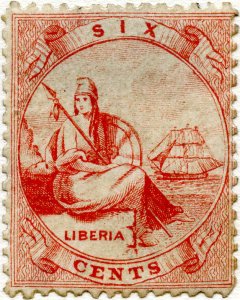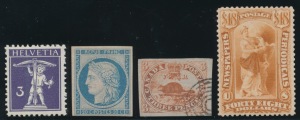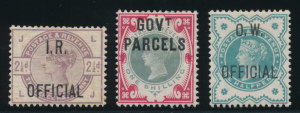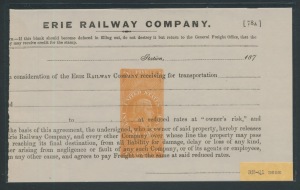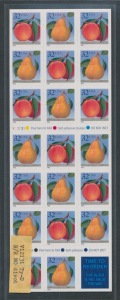Throughout philatelic history, writers have been predicting the next great philatelic area or specialty that will take off in price. Predictions are usually founded on one of two criteria that predict the supposed increase in popularity that the stamps will undergo. Either the economy of the country will take off creating a pool of desperate collectors eager to buy the older issues that you should have put away (if only you had listened to the prognosticator), or there is some intrinsic not fully understood rarity factor that collectors will ultimately discover which will make them eager to buy stamps that you (had you listened to the prognosticator) should have put away in quantity. The problem with predictions is that they tend to be very accurate in hindsight, and we tend to forget all the ones that haven't panned out. For the last fifty years, Brazil was always going to be the next best country. The economy was going to boom, and 120 million Brazilian collectors would enter the
Monthly Archives: December 2012
- Posted December 31, 2012Read more »
- Posted December 30, 2012Read more »The stamp business used to have what economists call high barriers to entry. It took a lot of knowledge, a lot of capital, and years of advertising and satisfying customers to build a good mailing list and a good stamp business. When the Internet became the preferred method of buying and selling in philately, there was considerable worry that old time stamp dealers would lose their competitive edge and that eBay and Stampwants would, overnight, make any seller a competitor of dealers who had spent decades building their sales networks.It has worked out somewhat differently. It is true that today anyone can be a seller with immediate access to the worldwide philatelic community. Twenty years ago only a few professionals had access to selling stamps to more than a few thousand customers, but today every seller has access to millions of worldwide collectors. But just as access has increased, so has clutter.
- Posted December 28, 2012Read more »Philately has always been a cold weather hobby. Its popularity nation to nation and region to region has always increased south to north with the highest concentrations of serious collectors where it is the coldest and darkest. The reasons are clear: a cup of hot chocolate, a stamp album, and some new additions to mount are a nice way to spend a blustery winter's evening. But, there are other reasons, too. Paper doesn't keep so well in warm, sticky climates, and literacy and reading rates, which are good predictors of philatelic interest, are higher in northern countries. We can see collector rates getting higher and higher the further from the equator that we move. Philately has always been a major hobby in Scandinavia, but even within countries the rate of stamp collecting increases as you move from the warmer parts of the country to the colder. In Germany, probably the most philatelically active nation, far more collectors live in the Northern, colder part of the country than the Southern.
- Posted December 27, 2012Read more »In the 1940s and 1950s, the terror of the philatelic world was Elliot Perry. Perry was a knowledgeable philatelist but a personal horror. Every philatelic dispute was to him a holy crusade. A suggestion that his opinion wasn't formed on Olympus enraged him to the point that he never forgave the miscreant who doubted him. He had a dispute with Harry Konwiser, another prominent philatelist, that may have started over a Confederate cover, but as was clear in their telling of it, neither retained much sense over what the dispute was originally about. The conflagration lasted decades and was public and acrimonious in the extreme. Perry made himself unassailable, not so much because he was so knowledgeable, but because he made the public price of disagreeing with him so very high. Eventually Perry passed on and is little remembered anymore.But the incivility and hostility that he brought to our hobby intimidated
- Posted December 26, 2012Read more »The desire to collect is innate and probably relates to the gatherer instinct that separates humans from other primates. But in a world in which one can collect everything from antique barbed wire to Victorian pocketbooks, why do people collect stamps? The answer, I think, comes down to three factors: community, size, and orderliness.First, most stamp collectors were introduced to the hobby by a relative or friend, and the feeling one has about philately gets infused with the feelings one has about the early sharing of your hobby with that important person in your life. Second, one can collect at a pretty high level over a period of years and yet store the entire collection on a couple of shelves. Some other hobbies have this advantage, but few have it as clearly as stamps. Most collectibles are far larger and harder to store than stamps. A philatelic collection of thousands can be kept in one album whereas
- Posted December 24, 2012Read more »Determining the existing quantities of different classic stamps has been one of the great difficulties of philatelic research. Before the days of the Internet, nearly all classic stamps that were sold were not illustrated so it was impossible for a census taker to know if he had counted a given specimen before. Counts of stamps such as United States 5
- Posted December 23, 2012Read more »For many years, few stamp collections required many steps be taken for their security. Few collections were valuable enough for the average burglar to bother with, and even if damaged by fire, the low value of stamps in general meant that they were easy to replace. But the rise in philatelic values in the last fifteen years, both actual and relative, to the rise in prices in general has made a good stamp collection eagerly sought after by even common criminals and difficult to replace in the case of fire loss.Most people never experience a house fire, and even though burglary rates are alarmingly high, most residential areas have few, and these are generally of the "steal the silver and run" kind. Still, statistics say that the average person can expect to be burglarized at least once in his or her lifetime, and some steps can be taken to mitigate the risk of losing your stamps.
- Posted December 21, 2012Read more »Readers of this blog are aware by now of how fashions change in philately. Used stamps were comparatively more popular fifty years ago than they are today. Covers and postal history were essentially uncollected until about 1920, had their peak around 1980, and have since fallen to a secure but niche collecting status. Blocks and multiples were once part of everyone's collection; today a single will do.No change in philatelic tastes though has been more profound than the current affection for original gum on Nineteenth Century stamps. One hundred years ago, collectors were routinely instructed to wash the gum off of their mint stamps. Early postage stamp gums were organically based and prone to bacterial infestation which shows up as "foxing" -those brown stains on the gum and paper which become even less appealing when you realize that they are bacterial excrement. Air conditioning
- Posted December 20, 2012Read more »Historians of the ancient world often have few sources to go on and much of our understanding of what happened before the last few centuries, for which written documents are common, is by inference. Thus we know of Phoenician settlements throughout the Mediterranean because of obelisks found on different sites inscribed with that language or by shards of pottery in Phoenician style. From coins we can infer that Hadrian was not always loyal to his wife, and all of what we know of Alexander is from histories written hundreds of years after his death when legend and lore surely colored fact.A thought game many philatelists engaged in years ago was to view stamps and their designs as the sole surviving historical record. An example of the game went like this: Suppose we were historians from the fourth millennium. The only historical materials that
- Posted December 19, 2012Read more »
Stamp design and messaging has changed over the course of the last one hundred years. For most of the nineteenth century, stamp design was simple and rarely changed. New issues were uncommon and Commemoratives unheard of. Design was meant to identify the label quickly as an official government item, a bearer bond so to speak, which indicated a prepaid service of a certain amount. The denomination needed to be clearly indicated (and most countries used color coding to help with denomination recognition- on US stamps the first class (3c) rate was red and the transcontinental rate (10c) was green), and the design needed to indicate the country of origin.Every country except Great Britain has always put its name on its postage stamps. But even in the earliest postage stamp designs the idea of national symbols was widely in use. Countries largely used pictures of past or present - Posted December 18, 2012Read more »The original format in which stamps were issued was full sheets. As time went on, postal authorities began to produce stamps for sale in more convenient formats for postal users. In the era before postage meters (and now, pre-printed postage indices), coil stamps were issued as the preferred method of stamp purchases for large mailing houses. Issued in rolls (sometimes up to as many as 10,000 in a single roll), the mailing houses could place these large rolls in their mailing machines and lower their labor costs as these stamps were automatically affixed. Individuals could buy coils, too (and some countries, such as Sweden largely had coils as their preferred method of stamp production), but for the most part coils were produced mainly for business use.Booklets represented a tremendous innovation in stamp design and sales, and were arguably the most consumer friendly innovation since the introduction
- Posted December 17, 2012Read more »Look for stories about the deteriorating relationship between Japan and China to be in the news over the next year. The two countries have a dispute over some islands in the China Sea, and the Japanese recently elected a far more aggressive government to deal with the perceived Chinese threat to Japanese interests. The Chinese are reacting to the feeling that the Japanese have long taken advantage of them. The chances are that this dispute will simmer along below the boiling point, mostly because both countries do so much business together, and they have so much to lose if the confrontations go beyond the verbal stage. But face must be saved, and should this area heat up beyond words, it wouldn't be the first time in history that countries put pride before self interest.Philatelists are students of recent history. Our stamps are tiny historical documents, and those of us who look beyond the paper
- Posted December 16, 2012Read more »Every field has its basic reading list, and people who have spent an enormous time in a particular field are apt to forget sometimes just how good some of the basics are. I have been rereading many of the philatelic works that I read as a young philatelist and am amazed at how interesting and timeless many of them are. At the top of this list is Nassau Street by Herman Herst.Herman "Pat" Herst Jr. (who got his nickname because he was born on St. Patrick's day) became a stamp dealer in the 1930s. The Depression era was really the start of the modern period of philately. Before the early 1930s, philately was a highly esoteric hobby that had not made it into the mainstream. Few people collected and not many people in the general population had any feel for what it was that philately was attempting to accomplish. The Depression era changed that for several reasons. First, there were a
- Posted December 14, 2012Read more »The first country to issue Official stamps was Great Britain. It did so at the same time that it issued the first stamp, the Penny Black. But Great Britain was scooped in one major aspect of Official stamps by the United States Post Office, and that was in the issuance of Departmental Officials
- Posted December 13, 2012Read more »Probably the best philatelic magazine that is published anywhere in the world is the "The American Philatelist", which is the monthly journal of the American Philatelic Society. Over eighty pages each month, the magazine serves partly as a member bulletin. But the real interest each month is the numerous detailed articles written by members, mostly about their collections and collecting interests.Philatelic scholarship has morphed over the years and "The American Philatelist" has been leading the change. This transformation has been the work of the editor of "The American Philatelist", Barbara Boal. Years ago, articles in philatelic journals carried titles like "A Study of the Cameos of the 1851 Portugal Dom Pedro's". These articles were read and admired and promptly forgotten, except for those collectors who saved them and reread them as a sleep aid. Today's articles
- Posted December 12, 2012Read more »The specialty area of United States Revenues may be the most fertile collecting specialty for collectors. Scott lists the general issue revenues which are interesting enough. But it is in the field of the specialty revenues where collectors have had the most fun. There are specialty Revenues for everything from Perfume Tax Stamps to Consular Office Revenues (which paid the tax on things like passports and visas), to even Marijuana Tax Stamps (which paid a tax on the illegal drug). Incidentally, Marijuana Tax Stamps were declared unconstitutional by the the Supreme Court as a form of self incrimination since it was illegal to sell marijuana without buying the stamps and paying the tax. But since it was illegal to sell pot anyway, this was ruled law enforcement double dipping. There are over thirty specialty revenues that the Scott catalog lists, and scores more of Scott unlisted revenue types
- Posted December 11, 2012Read more »One of the more ironic things about specialized philately is that collectors are far more likely to collect older issues in a highly specialized degree than they are to collect more modern stamps in the same degree of detail. Penny Blacks are specialized by plate number. There were 12 plates- each of which can only be told by detailed examination against known plated stamps) and 240 positions on each sheet (one for each set of check letters) making 2880 collectible stamps of the first postage stamp alone. Of the Penny Red of 1841, the second GB stamp, there are tens of thousands of different collectible varieties. Collectors of modern stamps usually collect only one of each, but this is out of habit. Many collectible varieties of modern stamps exist, and collectors of United States should be aware of this. The decision of how specialized to make your collection is yours alone, but this decision is easier to make if you are informed about varieties that are available.
- Posted December 10, 2012Read more »Confederate States philately has always enjoyed enormous popularity. The stamps are interestingly printed, served a real postal purpose, and the story behind the stamps has real philatelic appeal- large nation, rent by discord, one section withdraws from union to preserve the ability to own human beings as property, the other side fights to retain the union and end slavery. If it wasn't true it would seem unbelievable.Losers in wars and political conflict tend to gravitate to the stamps and postal history of their side as a way to identify with their cause and ameliorate their sense of loss. Baltic States philately between WWI and WWII, when these countries had been absorbed by the Soviet Union, is a case in point. Confederate States philately has always enjoyed great popularity in the south as kind of rebellion by proxy- collecting those stamps gave old time Confederate collectors succor for their sense
- Posted December 09, 2012Read more »Unbeknownst to a mass of collectors, one of the major changes brought about in our hobby as a result of the Internet age is greater democratization. In the pre-1900 period, philatelic organizations didn't count for much- there were few of them, and they had few members. The American Philatelic Society began to become powerful in the 1950s, and membership in the society became critical to success as a stamp collector or dealer. Stamp insurance was very difficult to obtain back then if you weren't an APS member, as APS stamp insurance was not only inexpensive but had expansive coverage limits and easy underwriting requirements. In this period too, most better stamps were sold at Public Auction, and extensive philatelic references were required by most auctioneers before your bids would even be accepted. APS membership provided the credentials that collectors and dealers alike needed to vet the transactions that were necessary to the hobby. As the societies became powerful,
- Posted December 07, 2012Read more »Every field has party games. Physicists have Schroedinger's cat. Theologists discuss the number of angels who can dance on the head of a pin. And philatelists discuss what country would be the hardest to complete and, if complete, what country would be the most valuable.The most difficult countries to complete would obviously be those for which there are unique stamps. Sweden has an error of color of the first stamp that they issued which is unique. This stamp has hopped around many auctions in recent years indicating that in whoever's vault it currently resides, it would only take money to pry it free. So Sweden would be very tough but not impossible. The US has a unique stamp too, the 1c Z grill (actually there are two 1c Z grills, but one is in the New York Public Library as part of the Miller collection. The New York Public Library


